In Nepal, rice planting isn’t just an agricultural task; it’s a cultural cornerstone that binds communities together. Each monsoon season, villagers gather to sow paddy seeds, engaging in vibrant celebrations like Ropai Jatra, which highlight their rich traditions. The region’s unique climate—characterized by monsoon rains and warm temperatures—creates ideal conditions for cultivating this staple crop, crucial for the country’s food security. However, the process of rice cultivation extends beyond mere planting; it encompasses various steps and practices that reflect the intricate relationship between agriculture and community life. What lies beneath these traditions and practices?
Key Points
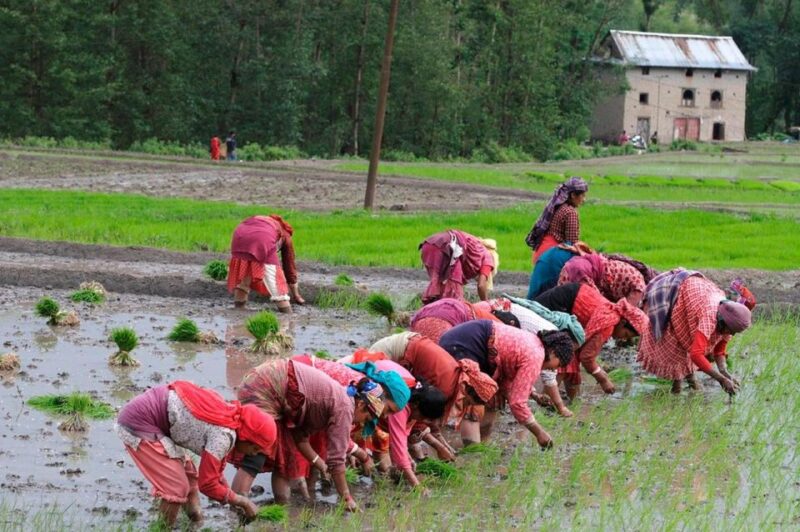
- Rice planting is vital to Nepal’s economy and cultural heritage, serving as a staple food for nutrition and food security.
- The monsoon season provides ideal conditions with ample rainfall, optimal temperatures, and high humidity for sowing paddy seeds.
- Community events like Ropai Jatra celebrate the rice planting tradition, fostering unity among families through participation and shared rituals.
- Traditional farming techniques, including seed selection and transplanting, are essential for maximizing rice yield and ensuring successful harvests.
- Cultural experiences during rice planting tours allow travelers to engage with local customs, learn agricultural practices, and enjoy authentic Nepali cuisine.
Importance of Rice Planting
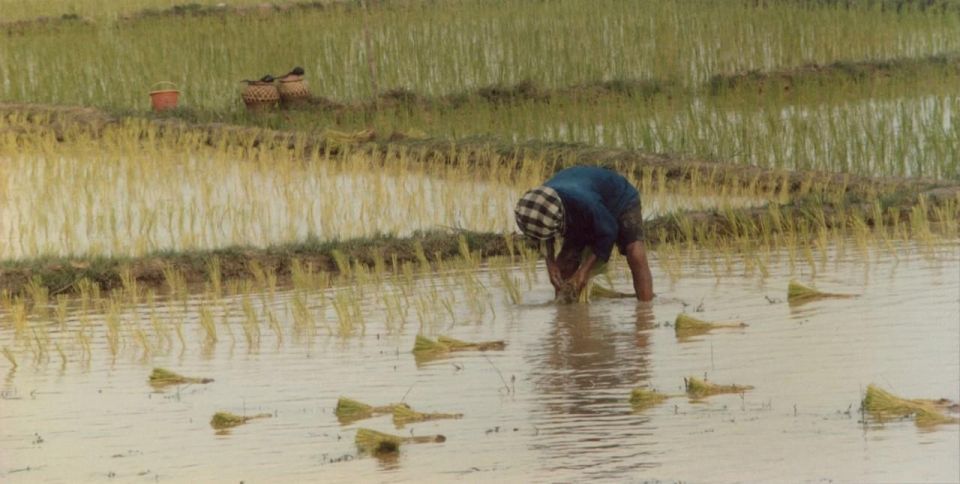
Rice planting isn’t just an agricultural activity in Nepal; it embodies cultural heritage and sustains the livelihoods of countless families across the nation.
This essential practice contributes significantly to Nepal’s economy, making agriculture a key player in the country’s GDP.
The arrival of the monsoon season transforms the landscape, creating ideal conditions for farmers to sow their paddy seeds.
Communities unite during this period, sharing knowledge and resources, which fosters a sense of togetherness.
On top of that, rice serves as a staple food, underpinning daily nutrition and food security for many households.
As farmers cultivate their fields, they also preserve traditional methods passed down through generations, ensuring that the cultural significance of rice planting remains alive and relevant in modern society.
You can also read our reviews of more tours and experiences in Nepal.
Traditional Festivals and Celebrations
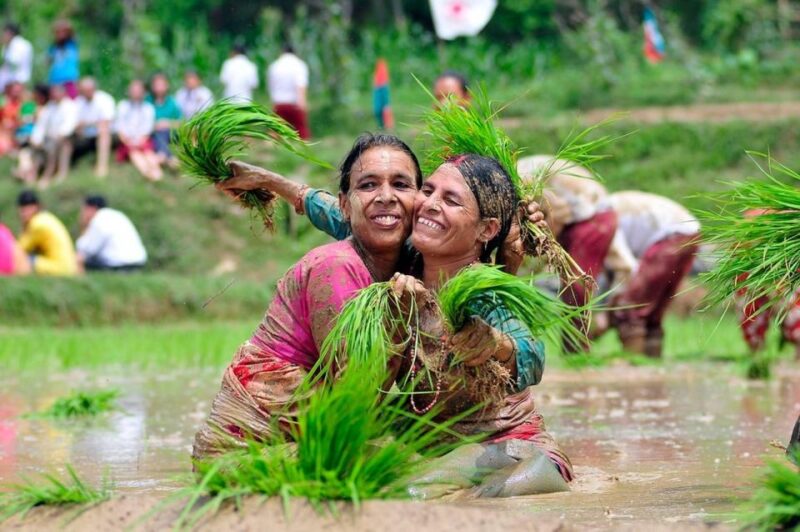
In Nepal, traditional festivals like Ropai Jatra celebrate the communal spirit and cultural heritage tied to paddy planting, bringing together families and communities in joyful festivities. During this vibrant occasion, participants engage in various activities that foster unity and tradition.
Key elements include:
-
Community Participation: Families and neighbors join hands to plant rice, strengthening bonds.
-
Cultural Performances: Traditional music and dance performances highlight the region’s rich heritage.
-
Ritual Offerings: People make offerings to deities for a bountiful harvest, showcasing spiritual beliefs.
-
Local Cuisine: Delicious Nepali dishes are prepared and shared, adding to the festive atmosphere.
These celebrations not only honor agricultural practices but also reinforce social ties, ensuring the continuation of cherished customs for future generations.
Ideal Weather Conditions
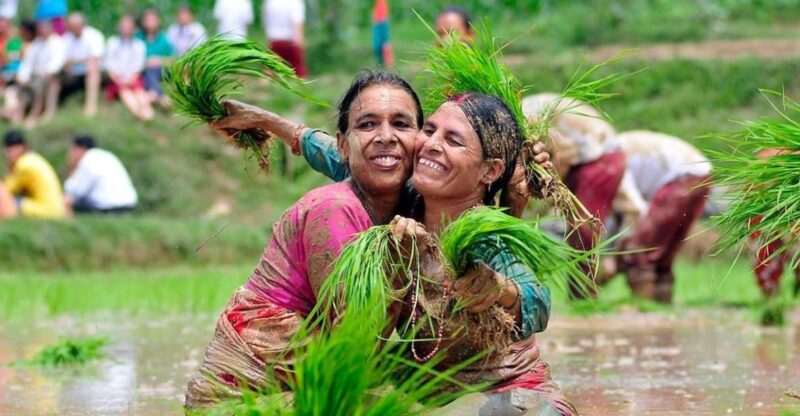
The monsoon season brings crucial rainfall that creates perfect conditions for paddy planting in Nepal. The heavy rains saturate the fields, making them suitable for sowing seeds. This period typically spans from June to September, providing the warm temperatures and humidity that rice plants thrive on.
| Weather Factor | Ideal Condition | Impact on Rice Planting |
|---|---|---|
| Rainfall | 100-150 mm/week | Ensures soil moisture |
| Temperature | 25-35°C | Promotes growth |
| Humidity | 70-90% | Aids in seed germination |
| Sunlight | 6-8 hours/day | Supports photosynthesis |
Farmers eagerly anticipate these weather patterns, as they ultimately determine the success of their harvest.
Steps in Rice Cultivation
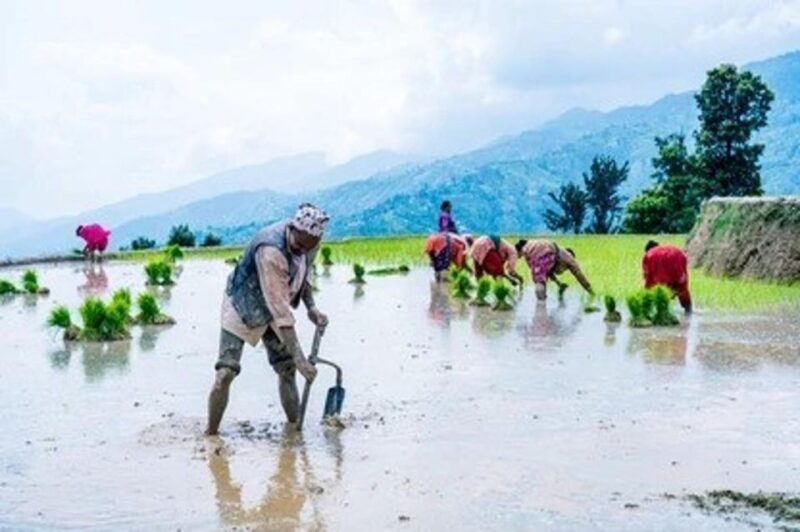
Cultivating paddy involves a series of carefully timed steps that ensure optimal growth and yield for farmers in Nepal. These steps are essential for successful rice production:
-
Seed Selection: Farmers choose high-quality seeds suitable for local conditions.
-
Field Preparation: They prepare the fields by plowing and leveling the land to create a suitable environment for planting.
-
Sowing: During the monsoon, farmers sow the seeds directly into the flooded fields, taking advantage of the wet conditions.
-
Transplanting: After a few weeks, seedlings are uprooted and transplanted to ensure proper spacing and growth.
Role of Cattle in Farming
Cattle play a crucial role in Nepalese farming, providing essential labor for plowing fields and serving as a source of organic manure that enriches the soil. Farmers rely on these animals not just for their strength but also for the sustainable benefits they offer. The following table highlights the contributions of cattle in farming:
| Contribution | Description |
|---|---|
| Plowing | Cattle help till the soil effectively |
| Manure Production | Provides nutrient-rich fertilizer |
| Transportation | Carries goods and produce |
| Weed Control | Helps manage unwanted vegetation |
| Cultural Importance | Integral to various farming rituals |
Incorporating cattle into agricultural practices not only enhances productivity but also supports a more eco-friendly approach to farming in Nepal.
Cultural Experiences for Tourists
Visitors often enjoy vibrant cultural experiences during their stay in Nepal, particularly through engaging with local farming traditions and festivities. These experiences offer a unique glimpse into the agricultural lifestyle of the Nepalese people.
Here are some highlights:
-
Participating in Ropai Jatra: Tourists can join the locals in celebrating the paddy planting festival, filled with music and dance.
-
Learning Traditional Farming Techniques: Hands-on activities allow visitors to learn how to sow and nurture paddy seeds.
-
Savoring Local Cuisine: Travelers enjoy authentic Nepali meals prepared by the community, showcasing the flavors of the region.
-
Exploring Rural Life: Taking in village life offers insights into the daily routines and customs of farmers.
These cultural experiences create lasting memories and deepen appreciation for Nepal’s agricultural heritage.
Itinerary for a Rice Planting Tour
Building on the cultural experiences that connect travelers with local traditions, the itinerary for a rice planting tour offers an immersive journey into the heart of Nepal’s agricultural practices.
The adventure begins in Thamel, where participants board a bus for a scenic six-hour ride to a traditional village. Upon arrival, travelers engage with local farmers, learning the intricate techniques of planting paddy. They experience the joy of Ropai Jatra, where community spirit thrives.
Tourists can also enjoy authentic Nepali meals and share stories with their hosts during their homestay in Dhading. This unique itinerary not only educates travelers about rice cultivation but also fosters a deep appreciation for Nepal’s rich agricultural heritage.
Booking and Tour Information
To experience the rich traditions of rice planting in Nepal, travelers can easily book their tour, which includes local transportation, homestays, and guided activities.
Here are four key features of the booking process:
-
Inclusive Packages: Tours include local transportation, comfortable homestays in Dhading, and authentic Nepali meals.
-
Guided Experience: An English-speaking guide accompanies travelers, enriching their understanding of local customs.
-
Flexible Cancellation: Guests can cancel their bookings for free up to 24 hours in advance, ensuring peace of mind.
-
Pay Later Option: Travelers can reserve their spot now and pay later, making the planning hassle-free.
Booking a tour not only connects travelers to Nepal’s agricultural heritage but also supports local communities.
Frequently Asked Questions
What Is the History of Rice Cultivation in Nepal?
The history of rice cultivation in Nepal dates back centuries. Over time, farmers adapted techniques to enhance yields, integrating cultural practices that reflect their connection to the land, fostering community involvement and sustaining livelihoods through generations.
How Does Rice Planting Affect Local Ecosystems?
Rice planting significantly impacts local ecosystems by fostering biodiversity, enhancing soil fertility, and supporting various wildlife. It creates wetland habitats, promotes nutrient cycling, and helps maintain regional water balance, ultimately benefiting both agriculture and the environment.
What Are Common Rice Varieties Grown in Nepal?
Common rice varieties grown include Basmati, Sawa, and Jethobudho. Farmers appreciate these types for their flavors and adaptability, ensuring they thrive in various conditions, contributing to both local diets and agricultural sustainability in the region.
Are There Any Health Benefits of Consuming Nepali Rice?
Nepali rice offers numerous health benefits; it’s rich in carbohydrates, provides energy, and contains essential vitamins and minerals. Its fiber content aids digestion, while its low glycemic index supports stable blood sugar levels, promoting overall wellness.
How Has Modern Technology Influenced Rice Farming in Nepal?
Modern technology has transformed rice farming significantly; farmers now use advanced machinery, precision irrigation, and mobile apps for weather updates. These innovations enhance efficiency, boost yields, and help farmers adapt to changing climate conditions effectively.
Recap
To sum it up, rice planting in Nepal goes beyond mere agriculture; it embodies the spirit of community and cultural heritage.
The vibrant festivals, ideal weather, and traditional practices create a rich tapestry of life for locals and visitors alike.
With each sowing season, communities unite, ensuring not only food security but also the preservation of their identity.
For travelers, experiencing this unique agricultural tradition offers a chance to witness and participate in the heart of Nepal’s rural life.
You can check availability for your dates here:More Tour Reviews in Nepal
Not for you? Here's more nearby things to do in Nepal we have reviewed
- Himalayan Sound Healing Workshop: Singing Bowl in Nepal.
- Nepal: Api Himal Trek to Base Camp
- Rolwaling Himal Trek 8 Days
- 10 Days Annapurna Circuit Trekking
- Indra Jatra Tour in Nepal
- Nagarjun Jamacho Day Hike Stunning Valley Himalayan Views
- Chitwan National Park Tours: 3 Nights 4 days Full Package
- Kathmandu-Pokhara Night Sofa Bus
- 10 Best Guided Tours In Nepal
- 25 Best Tours In Nepal
- 10 Best National Park Tours In Nepal
- Sunrise View From Sarangkot
